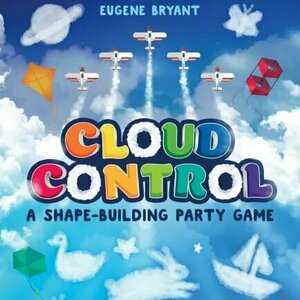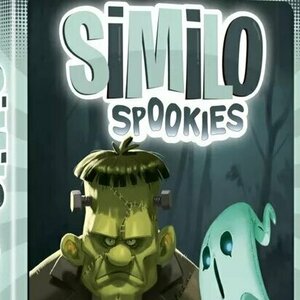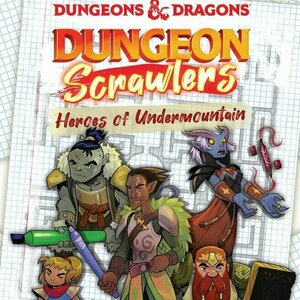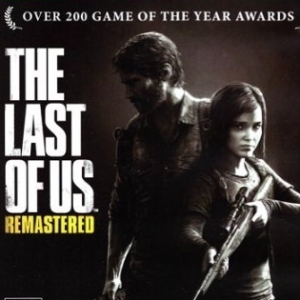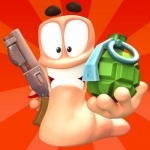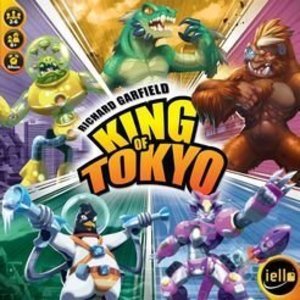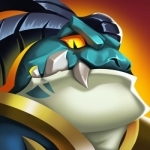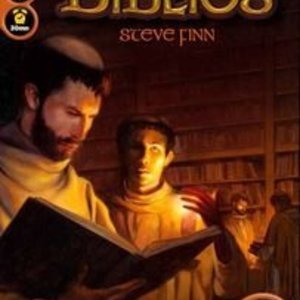Search
Search results
Purple Phoenix Games (2266 KP) rated Cloud Control in Tabletop Games
Dec 31, 2020
We see so often on TV and movies characters looking up at the sky and picking out figures in the clouds. Maybe they see elephants, or airplanes, or ice cream cones. Usually when I look up into the clouds I see impending rain showers, or snowflakes pelting my face, or merely barricades to the sun. I almost never get the fun shapes that I expect, sadly. But now, with Cloud Control in my arsenal, I can make any shape I wish. For victory points!
Cloud Control is a 3-10 player party game of building unique cloud shapes from cues on cards. By manipulating basic cloud shapes players must get their opponents to guess what they are building to score VP kites.
DISCLAIMER: We were provided a copy of this game for the purposes of this review. This is a retail copy of the game, so what you see in these photos is exactly what would be received in your box. I do not intend to cover every single rule included in the rulebook, but will describe the overall game flow and major rule set so that our readers may get a sense of how the game plays. For more in depth rules, you may purchase a copy online or from your FLGS. -T
To setup shuffle the cards into one gigantic pile or into smaller stacks, as shown below. Separate the square cloud shape cards by shape and place them into stacks by shape. Place the VP kites and sand timer nearby and determine the starting player. The game may now begin with the first cloud artist!
On a turn the active player will draw a Shape Card, choose one of the shapes and then have someone start the timer. Within the 90 seconds provided the player will need to grab Cloud Cards from the stacks to create their versions of the shapes prompted. Once the timer runs out, or other players correctly guesses what is being built, both the artist and guessers will receive point kites equal to the difficulty of the shapes identified. Easier creations will score 1VP while more difficult ones will score 3VP. Play then proceeds to the next player in table order to take their turn.
Once every player has had a turn to build, a lightning round will commence. The starting player will choose a Shape Card and then announce to all players the shape to be built. The players will have 90 seconds to each build the shape announced by taking only ONE Cloud Card at a time to add to their creation. Once the timer is out of sand, it is flipped once again for players to explain their creations. At the end of this arguing period all players will vote and the shape with the most votes will earn 5VP.
Players will each have one more turn to earn points for Shape Cards, and the winner is the player with the most VPs.
Components. This game is a bunch of Cloud Cards, 300 Shape Cards (plus extra blanks if you received the promos), VP kites, and a sand timer. The timer is normal sand timer quality, the cards used throughout the game are all fine quality, and the kites are cute red and gold tokens. The art style in the game is very light and airy and fits very well with the theme. Again, I have no problems with the components from 25th Century Games.
The gameplay is really fun, and turns (though 90 seconds long) seem like they go by so quickly that one could easily lose track of time playing. Having to work super fast because you are trying to score all the shapes on the card is harrying and stressful, or just a little less so if you decide to go big and detailed for just 3VP on one shape. Finding interesting uses for the basic shapes keeps all players active and on the edge of their seats. This truly is a wonderful party game (for when you can have game nights again).
Why didn’t I rate it higher then if I seem to like it so much? Well, for my typical game group, we tend to gravitate toward games with more meat on their bones. So I really do not see this getting played a ton on a regular rotation. That said, I am basing this on our game nights we had pre-COVID so things may certainly change once we are able to get together as a large group again. While I have played this with different player counts, I haven’t been able to get more than four to play. So I am keeping my rating open for now. I could see it improving down the road when I am able to play this with more people. I just really want to test its limit of 10 players and see how it goes. If it can handle 8+ and still be just as fun as with three or four, I will update this review and the graphic up top.
For now, Purple Phoenix Games gives this one a floaty 8 / 12. I do love being able to bust out my creative side and think more in geometric shapes. Every player I have played with seems to also enjoy it quite a bit. It is simple to teach and learn, plays quickly, and offers so many opportunities to laugh hysterically as players attempt to create common items or concepts from uncommon basic cloud shapes. If you are looking for something a little different to bring to game night or offer your friends and family, check out Cloud Control. And post some photos of your better creations. I want to see them!
Cloud Control is a 3-10 player party game of building unique cloud shapes from cues on cards. By manipulating basic cloud shapes players must get their opponents to guess what they are building to score VP kites.
DISCLAIMER: We were provided a copy of this game for the purposes of this review. This is a retail copy of the game, so what you see in these photos is exactly what would be received in your box. I do not intend to cover every single rule included in the rulebook, but will describe the overall game flow and major rule set so that our readers may get a sense of how the game plays. For more in depth rules, you may purchase a copy online or from your FLGS. -T
To setup shuffle the cards into one gigantic pile or into smaller stacks, as shown below. Separate the square cloud shape cards by shape and place them into stacks by shape. Place the VP kites and sand timer nearby and determine the starting player. The game may now begin with the first cloud artist!
On a turn the active player will draw a Shape Card, choose one of the shapes and then have someone start the timer. Within the 90 seconds provided the player will need to grab Cloud Cards from the stacks to create their versions of the shapes prompted. Once the timer runs out, or other players correctly guesses what is being built, both the artist and guessers will receive point kites equal to the difficulty of the shapes identified. Easier creations will score 1VP while more difficult ones will score 3VP. Play then proceeds to the next player in table order to take their turn.
Once every player has had a turn to build, a lightning round will commence. The starting player will choose a Shape Card and then announce to all players the shape to be built. The players will have 90 seconds to each build the shape announced by taking only ONE Cloud Card at a time to add to their creation. Once the timer is out of sand, it is flipped once again for players to explain their creations. At the end of this arguing period all players will vote and the shape with the most votes will earn 5VP.
Players will each have one more turn to earn points for Shape Cards, and the winner is the player with the most VPs.
Components. This game is a bunch of Cloud Cards, 300 Shape Cards (plus extra blanks if you received the promos), VP kites, and a sand timer. The timer is normal sand timer quality, the cards used throughout the game are all fine quality, and the kites are cute red and gold tokens. The art style in the game is very light and airy and fits very well with the theme. Again, I have no problems with the components from 25th Century Games.
The gameplay is really fun, and turns (though 90 seconds long) seem like they go by so quickly that one could easily lose track of time playing. Having to work super fast because you are trying to score all the shapes on the card is harrying and stressful, or just a little less so if you decide to go big and detailed for just 3VP on one shape. Finding interesting uses for the basic shapes keeps all players active and on the edge of their seats. This truly is a wonderful party game (for when you can have game nights again).
Why didn’t I rate it higher then if I seem to like it so much? Well, for my typical game group, we tend to gravitate toward games with more meat on their bones. So I really do not see this getting played a ton on a regular rotation. That said, I am basing this on our game nights we had pre-COVID so things may certainly change once we are able to get together as a large group again. While I have played this with different player counts, I haven’t been able to get more than four to play. So I am keeping my rating open for now. I could see it improving down the road when I am able to play this with more people. I just really want to test its limit of 10 players and see how it goes. If it can handle 8+ and still be just as fun as with three or four, I will update this review and the graphic up top.
For now, Purple Phoenix Games gives this one a floaty 8 / 12. I do love being able to bust out my creative side and think more in geometric shapes. Every player I have played with seems to also enjoy it quite a bit. It is simple to teach and learn, plays quickly, and offers so many opportunities to laugh hysterically as players attempt to create common items or concepts from uncommon basic cloud shapes. If you are looking for something a little different to bring to game night or offer your friends and family, check out Cloud Control. And post some photos of your better creations. I want to see them!
Purple Phoenix Games (2266 KP) rated Similo: Spookies in Tabletop Games
Mar 11, 2022
Anyone who knows my gaming preferences will tell you that I am not at all a fan of many party games. I just find them less that gratifying, with usually little to no skill or strategy involved, and also typically invites lewd and disgusting suggestions and behaviors. No thanks. However, upon seeing many reviewers that I trust showing off their hauls from recent conventions including games from the Similo series, I just had to find out why. Have I been missing out, or is this just another lame excuse for a “party game?”
Similo: Spookies (which I will just call Similo from here on out, as they are all basically the same, but with different themes) is a party card game where one player knows information and attempts to persuade the other players to choose the correct character SILENTLY. One game lasts five rounds or less, and many times players will want to play multiple games in a row.
To setup, shuffle the deck of cards and place it face-down on the table. The player chosen to be the “Clue Giver” will then secretly look at the top card. This card will be the secret character for the entire game. Along with this card, the Clue Giver will draw an additional 11 cards and shuffle them. Next, lay out the 12 characters face-up in a 4×3 grid, so that all players can see. Finally, the Clue Giver draws another five cards to act as their starting hand of clues. The game may now begin in earnest!
The game lasts no more than five rounds, and each round is played mostly the same. During the first round the Clue Giver will place a card from their hand onto the table in either Portrait or Landscape mode (I know there are different words to describe these orientations, but they are failing me now). When a card is in Portrait mode, the Clue Giver is letting the players know that the secret character has similarities to the played card. Landscape placement means that the secret character has differences from the card played.
At the end of the first round, the other players must discuss and decide one card from the grid to remove from play, based on the Clue Giver’s information. If the card removed is the secret character (or at any time the secret character is removed in this way) the players all immediately lose the game. However, if the players have removed an appropriate character card, then the game moves to the second round. Each subsequent round is played exactly the same way, except the number of cards removed will match the round number being played. For example, during the third round three cards will be removed. The only exception here is the very last fifth round. During this round there will only be two cards remaining, and the players will need to choose the correct one to win the game. Win or lose, all players will most likely request to play another game with a different Clue Giver.
Components. This game is 30 cards in a tuckbox. The cards are all great quality with excellent linen finish. They each have the character’s name on the upper left corner and a small thematic quip on the lower right corner. The big thing here is the utterly amazing character art by Naiade (Seasons, Tokaido, Isla Dorada, etc). They are each so wonderfully illustrated, and they have to be, considering the entire game is based on the similarity or differences of each card. I was so very pleasantly surprised to see this beautiful set of cards pop out of the box when I opened it. Zero issues with components here.
This game is low-key a thinking person’s puzzle. How can I get the group to exclude one card specifically and throw away all the others? What the heck is this Clue Giver trying to tell us? What exactly is an Oni? With the right group of gamers, especially those that share many inside jokes and experiences, this could be a nightly hit. Now, determining the difference between Frankenstein’s Monster and a Zombie may be harder than you thought, so do be careful with those technicalities.
This one really reminds me of a much more compact version of Deception: Murder in Hong Kong. There is a silent Clue Giver in both trying to guide the other players to the right answer using cards. If I can get the same feeling from a game featuring 30 cards versus about 300 I might have a replacement situation on my hands here.
For its tiny table presence, excellent artwork, and overall game play, Purple Phoenix Games gives this one a bone-chilling 4 / 6. I know at this very second that my score is hanging in the balance. I want it to be a 5 so very badly, and I feel that it may actually get there, assuming I can play with larger groups of people and a variety of types of gamers. For now, I am happy with the 4 it is assigned. If you are like me and didn’t know you needed a smaller game in your collection that can give similo experiences to bigger boxes, give this one a shot.
Oh PS – You can also combine the different sets into a larger and more chaotic game. I’m not sure I have the huevos for that quite yet, but I think a good counterpart to this Halloween-themed set may be the Fables or Myths sets. Let me know if you have combined these two and if my hunch is correct. I’m going to go fanboy over Naiade’s art now.
Similo: Spookies (which I will just call Similo from here on out, as they are all basically the same, but with different themes) is a party card game where one player knows information and attempts to persuade the other players to choose the correct character SILENTLY. One game lasts five rounds or less, and many times players will want to play multiple games in a row.
To setup, shuffle the deck of cards and place it face-down on the table. The player chosen to be the “Clue Giver” will then secretly look at the top card. This card will be the secret character for the entire game. Along with this card, the Clue Giver will draw an additional 11 cards and shuffle them. Next, lay out the 12 characters face-up in a 4×3 grid, so that all players can see. Finally, the Clue Giver draws another five cards to act as their starting hand of clues. The game may now begin in earnest!
The game lasts no more than five rounds, and each round is played mostly the same. During the first round the Clue Giver will place a card from their hand onto the table in either Portrait or Landscape mode (I know there are different words to describe these orientations, but they are failing me now). When a card is in Portrait mode, the Clue Giver is letting the players know that the secret character has similarities to the played card. Landscape placement means that the secret character has differences from the card played.
At the end of the first round, the other players must discuss and decide one card from the grid to remove from play, based on the Clue Giver’s information. If the card removed is the secret character (or at any time the secret character is removed in this way) the players all immediately lose the game. However, if the players have removed an appropriate character card, then the game moves to the second round. Each subsequent round is played exactly the same way, except the number of cards removed will match the round number being played. For example, during the third round three cards will be removed. The only exception here is the very last fifth round. During this round there will only be two cards remaining, and the players will need to choose the correct one to win the game. Win or lose, all players will most likely request to play another game with a different Clue Giver.
Components. This game is 30 cards in a tuckbox. The cards are all great quality with excellent linen finish. They each have the character’s name on the upper left corner and a small thematic quip on the lower right corner. The big thing here is the utterly amazing character art by Naiade (Seasons, Tokaido, Isla Dorada, etc). They are each so wonderfully illustrated, and they have to be, considering the entire game is based on the similarity or differences of each card. I was so very pleasantly surprised to see this beautiful set of cards pop out of the box when I opened it. Zero issues with components here.
This game is low-key a thinking person’s puzzle. How can I get the group to exclude one card specifically and throw away all the others? What the heck is this Clue Giver trying to tell us? What exactly is an Oni? With the right group of gamers, especially those that share many inside jokes and experiences, this could be a nightly hit. Now, determining the difference between Frankenstein’s Monster and a Zombie may be harder than you thought, so do be careful with those technicalities.
This one really reminds me of a much more compact version of Deception: Murder in Hong Kong. There is a silent Clue Giver in both trying to guide the other players to the right answer using cards. If I can get the same feeling from a game featuring 30 cards versus about 300 I might have a replacement situation on my hands here.
For its tiny table presence, excellent artwork, and overall game play, Purple Phoenix Games gives this one a bone-chilling 4 / 6. I know at this very second that my score is hanging in the balance. I want it to be a 5 so very badly, and I feel that it may actually get there, assuming I can play with larger groups of people and a variety of types of gamers. For now, I am happy with the 4 it is assigned. If you are like me and didn’t know you needed a smaller game in your collection that can give similo experiences to bigger boxes, give this one a shot.
Oh PS – You can also combine the different sets into a larger and more chaotic game. I’m not sure I have the huevos for that quite yet, but I think a good counterpart to this Halloween-themed set may be the Fables or Myths sets. Let me know if you have combined these two and if my hunch is correct. I’m going to go fanboy over Naiade’s art now.
Dean Gregory (18 KP) rated Scotland Yard in Tabletop Games
Jun 5, 2019
Clever asymmetrical gameplay (2 more)
Strategic
Beginner rules available for younger players
Catch Me If You Can
Scotland Yard is an asymmetrical game of deduction and deception, depending on which role you take. Mister X must move in secret to stay out of the reach of the law long enough to escape London (22 turns), while the detectives must work together to trap and capture him.
The board is a map of London divided into numbered stations and linked together by coloured lines, depicting routes and different modes of transport - yellow for taxis, blue for buses and red for the underground. There are also a handful of black routes for ferries, which are available only to Mister X under special rules.
The mechanic of a player moving in complete secret on a tabletop game is one I never would have thought was possible, but Scotland Yard manages to pull it off, and make it work well. Mister X plots their movements with the use of a special pad and paper by writing down the station number they occupy, covering it with the ticket they used to make their move. This is the only clue the detectives have as to where X might be. It works extremely well.
Mister X also has access to two special tickets - a X2 ticket allows them to make two moves in one, and a black ticket allows them to use any mode of transport, with the added bonus of showing them to take ferry routes. Smart use of these powers is necessary to get out of scrapes, as they also have to reveal their location every 5 moves, starting with move 3.
Detectives have a limited number of tickets for each mode of transport, so in order to win they need to coordinate their movements so they don't waste tickets unnecessarily. However, if there are less than 4 detective players, each detective not controlled by a player is replaced with a police officer who is universally controlled. The police can move freely without the need for tickets, making them far more versatile than detectives. This is presumably to balance the difficulty for smaller teams, but it ends up making a game with all 4 detectives considerably harder than a game with only 3. The level of care and consideration that must go into each move makes playing the detectives a completely different experience to playing as Mister X.
I came into the game thinking it would be heavily skewed in Mister X's favour. After all, most of the moves they make are in secret, they're completely unhindered by tickets, and they get a couple of special powers to boot. On top of that, the detectives first two moves are complete guesswork, so X gets a head start. In practice though, staying 3 steps ahead of the detectives is vital to survival, and when they work together well it can be ready for X to put themselves in an impossible situation. It takes careful planning to stay ahead of the game.
There is a beginner mode which is aimed at younger players. The differences are that the number of rounds Mister X needs to survive for is 13 instead of 22, red underground routes are unavailable to all players, and most of all, Mister X remains in the board all game, only disappearing on the turns where he would appear in the regular game. I can't really offer an opinion on this version, but I can see the appeal of it, even if it defeats the concept of the game a bit.
This is a bonafide classic, and a solid challenge no matter which role you take on. As long as the game doesn't devolve into a series of guesses and lucky breaks (which, due to the nature of Mister X's movements, can be a regular issue), it offers an evening of smart gameplay with a solid replay value.
The board is a map of London divided into numbered stations and linked together by coloured lines, depicting routes and different modes of transport - yellow for taxis, blue for buses and red for the underground. There are also a handful of black routes for ferries, which are available only to Mister X under special rules.
The mechanic of a player moving in complete secret on a tabletop game is one I never would have thought was possible, but Scotland Yard manages to pull it off, and make it work well. Mister X plots their movements with the use of a special pad and paper by writing down the station number they occupy, covering it with the ticket they used to make their move. This is the only clue the detectives have as to where X might be. It works extremely well.
Mister X also has access to two special tickets - a X2 ticket allows them to make two moves in one, and a black ticket allows them to use any mode of transport, with the added bonus of showing them to take ferry routes. Smart use of these powers is necessary to get out of scrapes, as they also have to reveal their location every 5 moves, starting with move 3.
Detectives have a limited number of tickets for each mode of transport, so in order to win they need to coordinate their movements so they don't waste tickets unnecessarily. However, if there are less than 4 detective players, each detective not controlled by a player is replaced with a police officer who is universally controlled. The police can move freely without the need for tickets, making them far more versatile than detectives. This is presumably to balance the difficulty for smaller teams, but it ends up making a game with all 4 detectives considerably harder than a game with only 3. The level of care and consideration that must go into each move makes playing the detectives a completely different experience to playing as Mister X.
I came into the game thinking it would be heavily skewed in Mister X's favour. After all, most of the moves they make are in secret, they're completely unhindered by tickets, and they get a couple of special powers to boot. On top of that, the detectives first two moves are complete guesswork, so X gets a head start. In practice though, staying 3 steps ahead of the detectives is vital to survival, and when they work together well it can be ready for X to put themselves in an impossible situation. It takes careful planning to stay ahead of the game.
There is a beginner mode which is aimed at younger players. The differences are that the number of rounds Mister X needs to survive for is 13 instead of 22, red underground routes are unavailable to all players, and most of all, Mister X remains in the board all game, only disappearing on the turns where he would appear in the regular game. I can't really offer an opinion on this version, but I can see the appeal of it, even if it defeats the concept of the game a bit.
This is a bonafide classic, and a solid challenge no matter which role you take on. As long as the game doesn't devolve into a series of guesses and lucky breaks (which, due to the nature of Mister X's movements, can be a regular issue), it offers an evening of smart gameplay with a solid replay value.
Purple Phoenix Games (2266 KP) rated Dungeon Scrawlers: Heroes of Undermountain in Tabletop Games
Apr 8, 2022
I’ve mentioned before that Travis and I are currently playing a D&D campaign with another friend. I’m the DM and those two dudes are my ever-entertaining party. The adventure we’re running at the moment is Dungeon of the Mad Mage, which takes place in Undermountain. So imagine my surprise whilst browsing my FLGS recently and came across this game: a D&D real-time maze racing game set in the very same dungeon as our current campaign! I knew then and there that I had to give it a shot. It’s not as involved and intensive as the actual campaign, but this game can be just as exciting. Keep reading to see why!
Dungeons & Dragons: Dungeon Scrawlers – Heroes of Undermountain (simply referred to as Dungeon Scrawlers from here on out) is a real-time line drawing maze race for 2-4 players. The goal? To crawl your way through the dungeon floors, defeating Monsters/collecting Treasures/casting Spells/and more to collect the most VP by the end of the game. To setup for a game, each player receives a marker and a random Character. Select the Dungeon you wish to play this game, and give the corresponding sheet to each player. Check the bottom of the Dungeon sheet to see if any special components are needed (more on this in a bit), grab a timer, and the game is ready to go! Pictured below is the setup for a 3-player game.
Once the timer begins, the race is on! Players all begin at the “Start” entrance of their sheet, and draw their path through the dungeon floor. When making your path, there are a few rules to follow. Your path must be one continuous, unbroken line – no dotted lines or ambiguous markings! Keep your path within the lines – don’t be drawing through walls, at risk of losing VP. And finally, whenever you enter a new room, you must interact with all elements within.
Inside the rooms of the dungeon, you will find Monsters, Treasures, Spells, Artifact Fragments, or Exotic Plants. Each is dealt with in a specific way, and award you VP when scoring the dungeon floor. To defeat a Monster, you must draw over and fully color it in. To case a Spell, you trace the indicated path. To collect a Treasure, you must completely outline the treasure icon on your sheet. Artifact Fragments are collected by connecting the stones in numerical order, and Exotic Plants are collected by simply drawing a line through them. If you leave a room and you have not interacted with every element within, you will earn negative VP for any elements you missed! Each player is given a Character at the game start, and these Characters provide special rules/abilities for use throughout the game. For example, the Barbarian allows you to only color a Monster head to complete it, instead of having to color the entire thing. And that could be a huge time-saver in the long run! So knowing your Character ability, and how to effectively utilize it, is a huge bonus in the game.
Some dungeon floors have special components that come into play. These are Orbs, Portals, Keys, and Prisoners. Orbs provide bonus VP, and their value decreases as they are collected. So collecting an Orb first earns you more VP than if you wait to collect the last one. Portals allow players to teleport between the portal entrance/exit, thus moving you to a new part of the dungeon floor. And Keys are collected throughout the dungeon, and allow players to open ‘locked’ doors of the corresponding color. Without the appropriate key, you can not pass through a locked door. And finally you may need to rescue some Prisoners who are trapped throughout the level.
The scrawl ends when a player has defeated the Boss Monster, but certain levels have different ending triggers, like collecting an Orb triggers the end. Once the level ends, all players must stop drawing. Players pass their sheet to the player on their left, and that player scores their run – kinda like how we used to do in school sometimes. Players record their scores, and the player with the highest score wins! I do have to say that the rulebook suggests a ‘complete’ game of Dungeon Scrawlers be a total of 3 dungeon floors – the player with the highest total score from all 3 floors is the winner. But you are always welcome to play with as many or as few dungeon floors as you wish.
I actually enjoyed this game more than I thought I would. I think the real-time race element is what gets me. You want to go as quickly as possible so you can amass the most points, but you also have to move carefully so as to not miss any elements, draw through walls, and ultimately earn negative VP. Also, each dungeon floor has so many different paths and options, it can be stressful choosing which way to go when you know you’re racing against other players. That being said, you’re kind of also playing a game of risk by trying to collect as many elements as possible. Maybe your opponent is gunning straight for the end-game trigger, and if you’re not fast enough you won’t collect enough VP this floor. Or maybe everyone is trying to be a completionist, collecting as many elements as possible, nobody wanting to be the person to trigger the end quite yet. There’s some good strategy to be had, and the real-time element enhances it.
To touch on components, this game is a set of dry-erase dungeon sheets and markers, and some cardboard tokens. The quality of the dry-erase sheets and markers is pretty decent, and honestly better than I was expecting. In total, there are 10 different dungeon sheets, and each is unique and interesting. The cardboard tokens are thick and chunky, and will definitely hold up to many plays. Overall, great production quality!
So do I like Dungeon Scrawlers? Yes! It’s a fun, fast-paced game that is easy to teach, learn, and play. It’s pretty light-hearted but still gives you some strategic options with the real-time pressure. It’s not necessarily one that I’ll pull out at every game night, but it’s one that I can definitely use as a quick little filler, introductory game, or a game to use with younger gamers! This game is a neat concept that is executed well, and it makes for a fun time for all players. Purple Phoenix Games gives this one a scrawling 4 / 6. This game sounds easy, but add that real-time race and it gets a whole lot harder!
Dungeons & Dragons: Dungeon Scrawlers – Heroes of Undermountain (simply referred to as Dungeon Scrawlers from here on out) is a real-time line drawing maze race for 2-4 players. The goal? To crawl your way through the dungeon floors, defeating Monsters/collecting Treasures/casting Spells/and more to collect the most VP by the end of the game. To setup for a game, each player receives a marker and a random Character. Select the Dungeon you wish to play this game, and give the corresponding sheet to each player. Check the bottom of the Dungeon sheet to see if any special components are needed (more on this in a bit), grab a timer, and the game is ready to go! Pictured below is the setup for a 3-player game.
Once the timer begins, the race is on! Players all begin at the “Start” entrance of their sheet, and draw their path through the dungeon floor. When making your path, there are a few rules to follow. Your path must be one continuous, unbroken line – no dotted lines or ambiguous markings! Keep your path within the lines – don’t be drawing through walls, at risk of losing VP. And finally, whenever you enter a new room, you must interact with all elements within.
Inside the rooms of the dungeon, you will find Monsters, Treasures, Spells, Artifact Fragments, or Exotic Plants. Each is dealt with in a specific way, and award you VP when scoring the dungeon floor. To defeat a Monster, you must draw over and fully color it in. To case a Spell, you trace the indicated path. To collect a Treasure, you must completely outline the treasure icon on your sheet. Artifact Fragments are collected by connecting the stones in numerical order, and Exotic Plants are collected by simply drawing a line through them. If you leave a room and you have not interacted with every element within, you will earn negative VP for any elements you missed! Each player is given a Character at the game start, and these Characters provide special rules/abilities for use throughout the game. For example, the Barbarian allows you to only color a Monster head to complete it, instead of having to color the entire thing. And that could be a huge time-saver in the long run! So knowing your Character ability, and how to effectively utilize it, is a huge bonus in the game.
Some dungeon floors have special components that come into play. These are Orbs, Portals, Keys, and Prisoners. Orbs provide bonus VP, and their value decreases as they are collected. So collecting an Orb first earns you more VP than if you wait to collect the last one. Portals allow players to teleport between the portal entrance/exit, thus moving you to a new part of the dungeon floor. And Keys are collected throughout the dungeon, and allow players to open ‘locked’ doors of the corresponding color. Without the appropriate key, you can not pass through a locked door. And finally you may need to rescue some Prisoners who are trapped throughout the level.
The scrawl ends when a player has defeated the Boss Monster, but certain levels have different ending triggers, like collecting an Orb triggers the end. Once the level ends, all players must stop drawing. Players pass their sheet to the player on their left, and that player scores their run – kinda like how we used to do in school sometimes. Players record their scores, and the player with the highest score wins! I do have to say that the rulebook suggests a ‘complete’ game of Dungeon Scrawlers be a total of 3 dungeon floors – the player with the highest total score from all 3 floors is the winner. But you are always welcome to play with as many or as few dungeon floors as you wish.
I actually enjoyed this game more than I thought I would. I think the real-time race element is what gets me. You want to go as quickly as possible so you can amass the most points, but you also have to move carefully so as to not miss any elements, draw through walls, and ultimately earn negative VP. Also, each dungeon floor has so many different paths and options, it can be stressful choosing which way to go when you know you’re racing against other players. That being said, you’re kind of also playing a game of risk by trying to collect as many elements as possible. Maybe your opponent is gunning straight for the end-game trigger, and if you’re not fast enough you won’t collect enough VP this floor. Or maybe everyone is trying to be a completionist, collecting as many elements as possible, nobody wanting to be the person to trigger the end quite yet. There’s some good strategy to be had, and the real-time element enhances it.
To touch on components, this game is a set of dry-erase dungeon sheets and markers, and some cardboard tokens. The quality of the dry-erase sheets and markers is pretty decent, and honestly better than I was expecting. In total, there are 10 different dungeon sheets, and each is unique and interesting. The cardboard tokens are thick and chunky, and will definitely hold up to many plays. Overall, great production quality!
So do I like Dungeon Scrawlers? Yes! It’s a fun, fast-paced game that is easy to teach, learn, and play. It’s pretty light-hearted but still gives you some strategic options with the real-time pressure. It’s not necessarily one that I’ll pull out at every game night, but it’s one that I can definitely use as a quick little filler, introductory game, or a game to use with younger gamers! This game is a neat concept that is executed well, and it makes for a fun time for all players. Purple Phoenix Games gives this one a scrawling 4 / 6. This game sounds easy, but add that real-time race and it gets a whole lot harder!
Gareth von Kallenbach (980 KP) rated The Last of Us Remastered in Video Games
Jun 19, 2019
There are those who think that remakes of films and games are a bad idea
as they believe that they show a lack of creativity and originality.
However when a game is remastered it can be another story entirely.
Many classics from the past have had a graphical update especially PS 1-2
classics that were brought up to modern standards for the PS 3.
However when a game is remastered less than a year after the original game
was released, many are sure to have questions.
With The Last of Us Remastered, Naughty Dog has given Playstation 4 fans
what they have wanted, a top-flight game with a winning online component
and the amazing DLC that extended the story behind the award winning
original game for the PS 3.
The original game was a defining statement for the PS 3 but the game
pushed the system to the limits and with the PS 4 following soon after and
not being backwards compatible, a PS 4 version of the game was the best
option.
The game shines as the graphics have been taken to an even higher level
and the faster frame rates and smooth play let you really enjoy the
immersive world of the game as well as taking the horror to the next
level.
Playing as survivors from a Zombie like outbreak, players embark on an
escort mission to take a young girl to safety who may just hold the fate
of humanity in her blood.
The horror, violence, weapon crafting, and great narrative are all here,
and better than ever.
As a fan of the game, I had wondered if remastered graphics would be
enough to get players to want to play through a game again or if it was
mainly for those who had yet to purchase the game.
I have enjoyed the multiplay although I did have some long waits in my
connection, which thankfully have been addressed in the latest patch.
My wife had a interest in the PS 3 version of the game although horror
games are not her thing. When I started up the PS 4 version of the game
she was riveted to the tense opening scenes and narratives.
In the end there will be those who say that they do not want to play for a
game they have only recently purchased but Naughty Dog reduced the price $10.00 and added on the bonus content to make the investment a much better deal.
When you look at all the DLC content, episodes, as well as the ability to
screen cap and stream your action on the PS 4, to say nothing of the jaw
dropping visuals, The Last of Us Remastered is a must own for PS 4 fans as
they have made a near perfect game even better.
http://sknr.net/2014/08/12/the-last-of-us-remastered/
as they believe that they show a lack of creativity and originality.
However when a game is remastered it can be another story entirely.
Many classics from the past have had a graphical update especially PS 1-2
classics that were brought up to modern standards for the PS 3.
However when a game is remastered less than a year after the original game
was released, many are sure to have questions.
With The Last of Us Remastered, Naughty Dog has given Playstation 4 fans
what they have wanted, a top-flight game with a winning online component
and the amazing DLC that extended the story behind the award winning
original game for the PS 3.
The original game was a defining statement for the PS 3 but the game
pushed the system to the limits and with the PS 4 following soon after and
not being backwards compatible, a PS 4 version of the game was the best
option.
The game shines as the graphics have been taken to an even higher level
and the faster frame rates and smooth play let you really enjoy the
immersive world of the game as well as taking the horror to the next
level.
Playing as survivors from a Zombie like outbreak, players embark on an
escort mission to take a young girl to safety who may just hold the fate
of humanity in her blood.
The horror, violence, weapon crafting, and great narrative are all here,
and better than ever.
As a fan of the game, I had wondered if remastered graphics would be
enough to get players to want to play through a game again or if it was
mainly for those who had yet to purchase the game.
I have enjoyed the multiplay although I did have some long waits in my
connection, which thankfully have been addressed in the latest patch.
My wife had a interest in the PS 3 version of the game although horror
games are not her thing. When I started up the PS 4 version of the game
she was riveted to the tense opening scenes and narratives.
In the end there will be those who say that they do not want to play for a
game they have only recently purchased but Naughty Dog reduced the price $10.00 and added on the bonus content to make the investment a much better deal.
When you look at all the DLC content, episodes, as well as the ability to
screen cap and stream your action on the PS 4, to say nothing of the jaw
dropping visuals, The Last of Us Remastered is a must own for PS 4 fans as
they have made a near perfect game even better.
http://sknr.net/2014/08/12/the-last-of-us-remastered/
Rikki Hammond (33 KP) rated King of Tokyo in Tabletop Games
Jun 4, 2019
Easy to teach (2 more)
Great at all player counts
Looks visually great
Games are over far too quickly sometimes (1 more)
Some cards are far too overpowered
Yahtzee With Monsters
Please note, this review is for the first edition of the game.
King of Tokyo is one of the first games I bought for myself, when I got back into board gaming years ago, and it's definitely a fantastic light filler game, that will appeal to all ages.
Players choose a monster, and then take it in turns rolling six custom dice up to three times (like Yahtzee,) to either attack other players, heal their own health, gain 1,2 or 3 victory points, or collect energy.
Once one player attacks another, they enter Tokyo, and gain an extra victory point for each turn they are in there, however, everyone else can attack you, and you can't heal, but your attacks hurt everyone else to counteract this. You can decide to exit Tokyo, which will put the last player who attacked you in there instead.
Energy is used to buy special cards that help you out in one way or another. This can be anything from allowing you to roll an additional die, to giving you an extra life if you are destroyed. Each card has a different energy cost to buy them, and generally the better cards cost more, although some cards cost very little, but can be very overpowered, which can throw a little imbalance in the game.
A player wins by either destroying all other monsters, or by gaining 20 victory points (although it's usually the former that occurs.)
King of Tokyo is a lot of fun, but sometimes the games can be over far too quickly, especially if someone gets lucky with the attack rolls and card purchases, and sometimes players can be eliminated early on, leaving them to sit and watch as the rest of the game is played.
Overall, I would recommend King of Tokyo to casual gamers, and those starting out in gaming, especially those with kids, as it's light, easy to teach, and fun to play.
King of Tokyo is one of the first games I bought for myself, when I got back into board gaming years ago, and it's definitely a fantastic light filler game, that will appeal to all ages.
Players choose a monster, and then take it in turns rolling six custom dice up to three times (like Yahtzee,) to either attack other players, heal their own health, gain 1,2 or 3 victory points, or collect energy.
Once one player attacks another, they enter Tokyo, and gain an extra victory point for each turn they are in there, however, everyone else can attack you, and you can't heal, but your attacks hurt everyone else to counteract this. You can decide to exit Tokyo, which will put the last player who attacked you in there instead.
Energy is used to buy special cards that help you out in one way or another. This can be anything from allowing you to roll an additional die, to giving you an extra life if you are destroyed. Each card has a different energy cost to buy them, and generally the better cards cost more, although some cards cost very little, but can be very overpowered, which can throw a little imbalance in the game.
A player wins by either destroying all other monsters, or by gaining 20 victory points (although it's usually the former that occurs.)
King of Tokyo is a lot of fun, but sometimes the games can be over far too quickly, especially if someone gets lucky with the attack rolls and card purchases, and sometimes players can be eliminated early on, leaving them to sit and watch as the rest of the game is played.
Overall, I would recommend King of Tokyo to casual gamers, and those starting out in gaming, especially those with kids, as it's light, easy to teach, and fun to play.
Kelly (279 KP) rated Idle Heroes - Idle Games in Apps
Dec 5, 2018
Ideal for time wasting
I originally trialled this game in order to get free credits for another game, but rather than delete it after achieving the desired goal, I have kept pursuing it.
The game itself involves the development of heroes, you start by building up 3 star and 4 star heroes, progressing towards 10 stars. Initially I found it quite fast to develop 5 star heroes, collecting my daily bonuses from activities to speed up the process. Progressing to six star +, brings a whole new level of challenge, as you need to merge specific heroes together - I have found that this takes a lot more time in order to collect the correct amount of resources.
The creators of the game provide a large number of diamonds on a daily basis, which is beneficial to players, as it means you do not have to spend money in order to progress through the game. There are paid options if desired, where you can purchase VIP, which gives you access to additional aspects to help speed the game.
Heroes can be used in battle against the computer in the tower of oblivion and various other forums within the game, but you do find you become stuck at a level, sometimes for many days whilst trying to up grade.
To support the social aspect of the game, there is the option to join a guild. If the guild is active and works together, then this supports the development of your own team. One thing I have found on this game, is that there is a lack of audience of the game at the moment, and a large number of inactive players. This has meant that guilds do struggle to start up. The game also operates across several servers which cannot interact with each other, meaning friends need to be directed to join specific servers (and will have to carry out the introduction activities twice).
All in all the game is enjoyable and addictive, however it does have a few flaws, which I am hoping will be ironed out with time.
The game itself involves the development of heroes, you start by building up 3 star and 4 star heroes, progressing towards 10 stars. Initially I found it quite fast to develop 5 star heroes, collecting my daily bonuses from activities to speed up the process. Progressing to six star +, brings a whole new level of challenge, as you need to merge specific heroes together - I have found that this takes a lot more time in order to collect the correct amount of resources.
The creators of the game provide a large number of diamonds on a daily basis, which is beneficial to players, as it means you do not have to spend money in order to progress through the game. There are paid options if desired, where you can purchase VIP, which gives you access to additional aspects to help speed the game.
Heroes can be used in battle against the computer in the tower of oblivion and various other forums within the game, but you do find you become stuck at a level, sometimes for many days whilst trying to up grade.
To support the social aspect of the game, there is the option to join a guild. If the guild is active and works together, then this supports the development of your own team. One thing I have found on this game, is that there is a lack of audience of the game at the moment, and a large number of inactive players. This has meant that guilds do struggle to start up. The game also operates across several servers which cannot interact with each other, meaning friends need to be directed to join specific servers (and will have to carry out the introduction activities twice).
All in all the game is enjoyable and addictive, however it does have a few flaws, which I am hoping will be ironed out with time.
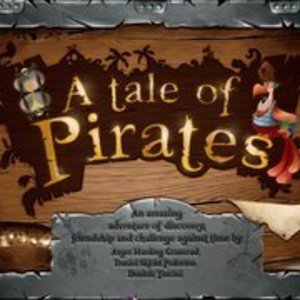
A Tale of Pirates
Tabletop Game
Put on your captain's hat and navigate the 3D pirate ship using sand timers in this unique real-time...
